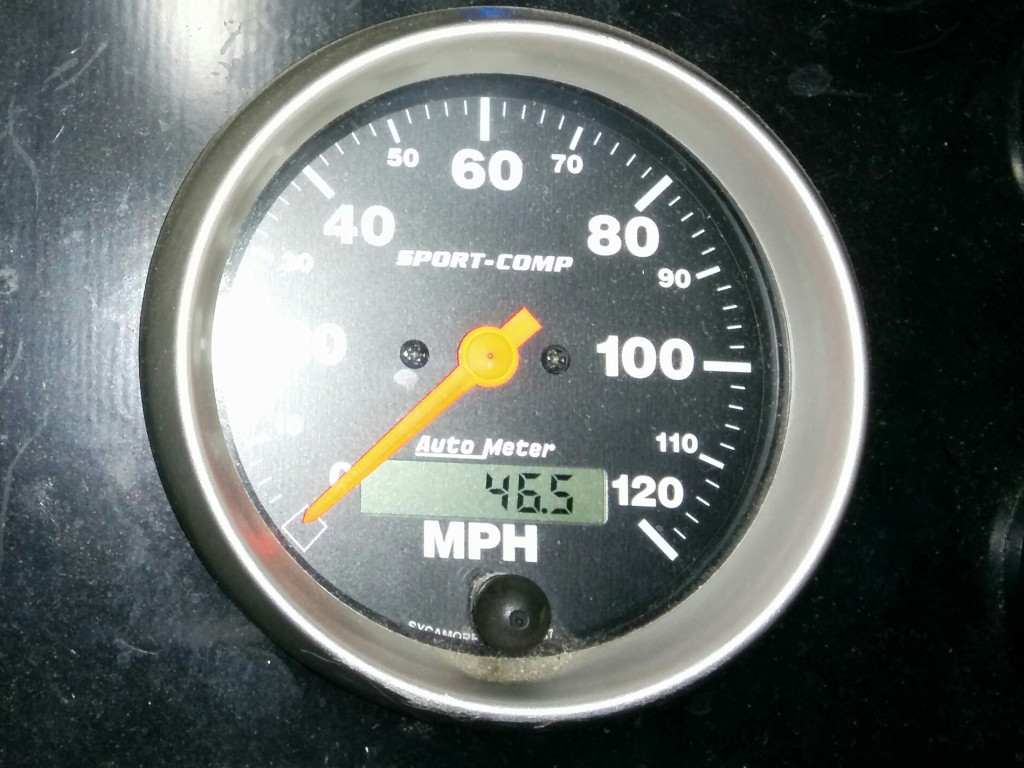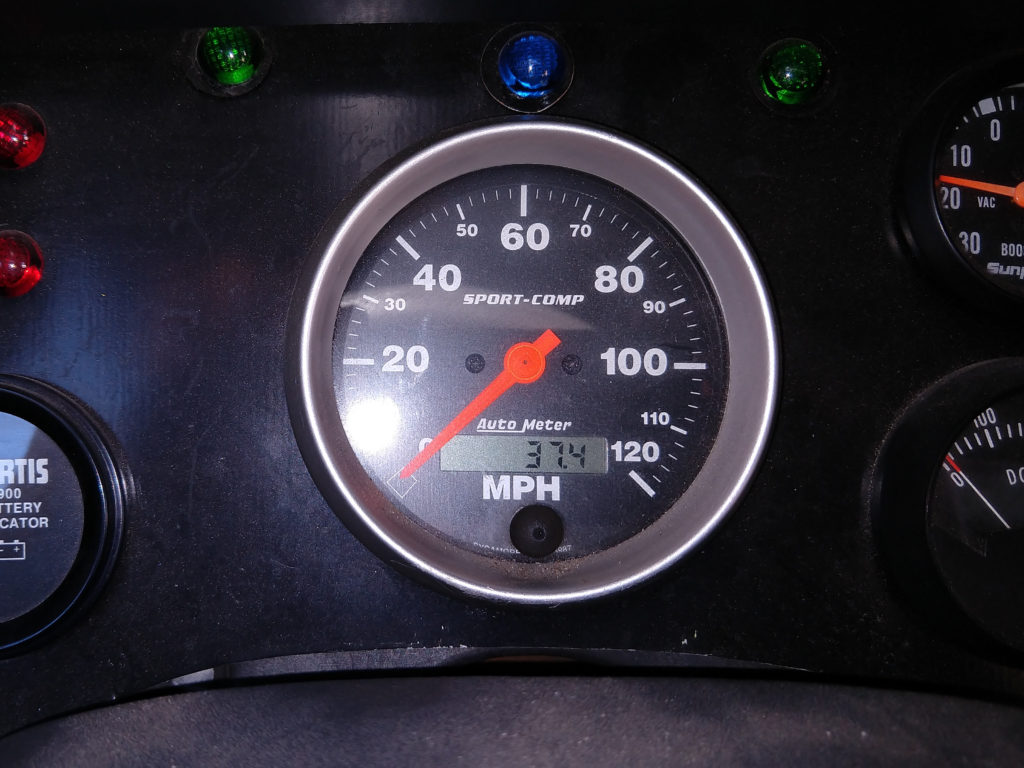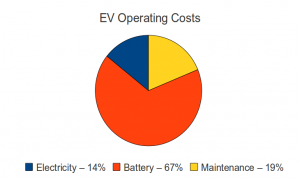Summary: I drove my truck 46 miles on one charge (and had some juice left over).

When you have an electric vehicle, everybody wants to know how far it can go.
I typically tell them “19,800 miles so far.”
But then you have to answer their real question, which is “What’s your range on a single charge?”. If you have a commercial EV like the Leaf or a Tesla, you can just refer to the EPA range figure for a nice apples to apples comparison. But when you have a conversion EV, the number is unique to your particular vehicle, motor, controller, battery pack and testing methodology. (And changes as the pack ages…)
I used to know the answer to that question for my truck with a (new) lead acid battery pack (“25-30 miles without killing the pack”), but I haven’t fully characterized the trucks’ power usage and range with the new (lighter weight, more powerful) pack made up of Nissan Leaf cell modules. My truck is heavier and has more air resistance than a stock Nissan leaf, the motor/controller is slightly less efficient, and the (big fat!) tires have quite a bit more rolling resistance. I figured “half the range of a Leaf” would be a good ballpark estimate.
Also important to note is that temperature and the types of driving you do plays a big factor in the number of watt hours consumed per mile driven and hence, range. In my drive yesterday, I was able to maintain a speed of between 30-40 mph with very few stoplights, the temperature was around 70 degrees, and using only the headlights I averaged 326 watt hours per mile. When driving in the winter when the temperature is closer to freezing, using the heater full blast, doing small stop & go driving in the 25-30 mph range, I have seen energy usage above 700 watt hours per mile.
Because I do not (yet) have an amp hour meter installed in my truck, the only way I have to tell how much power I used is to re-charge it, and see how much power it takes to fill it back up. This is known as a “from the wall” measurement, as it includes any charging inefficiencies as well as the power used to drive the truck. The shorter my trip, the more charging inefficiencies influence the final numbers, so when I recharge after a short 4 mile trip in the winter, I can get a usage of 875 watt hours per mile.
The lack of an AH meter also means I have no “fuel gauge” other than the overall pack voltage and a cell low voltage warning “beeper” from my BMS system. (And ideally, the beeper will never go off!) With Lithium ion batteries, overall pack voltage (and the individual cell voltage it is based upon) is not directly correlated to the state of charge except when the cells are nearing fully charged, or fully discharged. However, I can get a general feel for the overall charge level by looking at the voltages of the cells when they are “resting” (not driving the truck, or just coasting along with my foot off of the accelerator).
Above 131 volts means that it’s just been charged and is basically full (4.1 volts per cell).
When it gets down to 128 volts that means I’ve used about 20% of the energy. I have picked 120 volts (3.75 volts per cell) as my conservative “empty” point. [Some people would use 118 volts (3.68 volts per cell) or even lower.]
When I drove the truck to 46 miles, I was keeping an eye on the overall pack voltage anytime I was stopped (at a stoplight, for example) and I had resolved to abort the test (a small loop around my house) when it reached that point. However, it was late at night and I got tired of driving, so I quit before reaching my 120 volt cutoff point. When I finished the drive, my resting pack voltage was 122.8 volts (3.82 volts per cell average). I measured all the cells with a voltmeter to check and see how well balanced the pack was, and the lowest cell was 3.814 volts, while the highest was 3.85 volts. [So they are relatively well balanced, but could be better.]
When I re-charged, it took 15 kWh (15,000 watt hours / 46 miles = 326 wh/mi). Note that since I’m measuring this with an analog, uncalibrated kWh meter, the level of precision is necessarily low.
The theoretical capacity of a (new) Nissan leaf pack is in the 22-24 kWh range, depending upon how much of the pack you are willing to use. I’m trying to never use more than 18-19 kWh (80% discharged) to maximize battery life. Since 15 < 18, I didn’t quite drive to “empty”.
Assuming I had driven for 3,000 more watt hours at 326 wh/mi, I could have gone another 9.2 miles, or had a usable range of 55 miles. So, in good weather, not using the heater, driving moderately long distances at lowish (30-40mph) speeds with few stops, my range is in the 46-55 mile range, or about half that of a Nissan Leaf.



I converted my chevy s-10 convertion from lead 156v to lithium Iron phosphate 180v
with Calb SE 100 cells
also used heating pads in the battery boxes to maintain temps over 45*f in winter
because charging lithium batteries at temps below 40 risks destroying them. fire results apon charging after such damage .
got my knowledge off http://www.EVTV.ME
do you have an amp hour meter?
on paper my pack is 18kwh, but under load the volts drop and I find a real world figure of 13.5 kwh (yes I also under charge
fully charged for this chemistry is 3.4v per cell.
my resting volts after charge are 3.33,
I may sneak it up higher in time.
hi this is cooper and I was wondering where you got your leaf batteries from. Did you just find a scrapped one or do you know someone/a source that you knew of?
I purchased a salvage Nissan Leaf and removed the modules for this project. You can read all about it on my blog by clicking on the “leaf” tag or by following this link:
https://www.summet.com/blog/tag/leaf/
Pingback: Salvage 2013 Nissan Leaf modules – 7 year old range update | Jay's Technical Talk